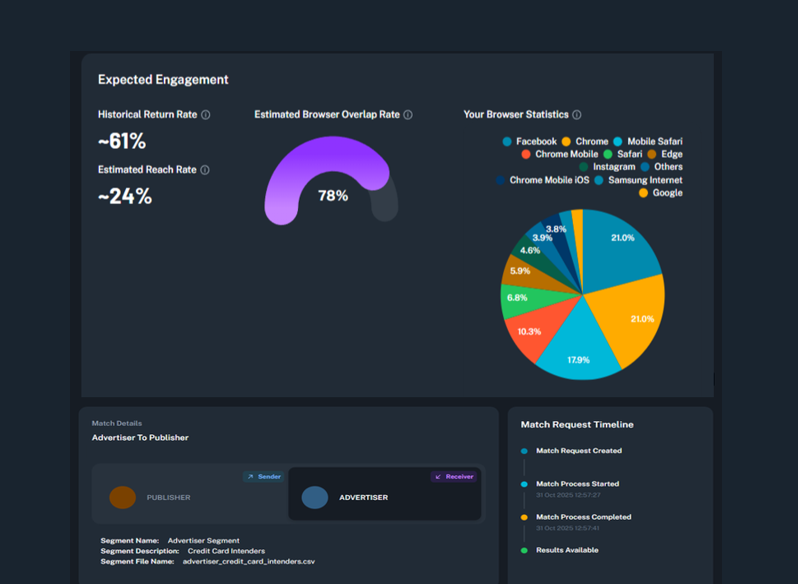What's in this post:
- Understanding the Basics: What Are Third-Party Cookies?
- The Timeline: Key Dates for Third-Party Cookie Deprecation
- Impact on Digital Marketing: What Changes?
- Privacy Sandbox: Google's Alternative Framework
- The Role of First-Party Data in Future Marketing Efforts
- Legal and Regulatory Considerations in a Post-Cookie Era
- Case Studies: Successful Transitions by Leading Brands
- Conclusion: Embracing Change and Preparing for the Future
Introduction
As the digital world braces for a seismic shift, the impending demise of third-party cookies heralds a new era for marketers, advertisers, and data-driven professionals. Google's decision to phase out third-party cookies in Chrome by the third quarter of 2024 first quarter 2025 marks a pivotal moment in the evolution of online privacy and digital marketing. This change, driven by increasing privacy concerns and regulatory pressures, compels marketers to rethink strategies that have long relied on these tracking mechanisms to understand and influence consumer behavior.
The curtain call for third-party cookies is not just a technical update; it is a fundamental shift that challenges the traditional paradigms of targeted advertising and personalized marketing. As we navigate through this transition, understanding the implications, preparing for the changes, and exploring new tools and methodologies will be crucial. This blog post aims to demystify the landscape post-third-party cookies, offering insights and strategies to help marketers adapt to and thrive in a cookieless world. Join us as we explore the future of digital marketing where privacy, transparency, and innovation become the cornerstones of connecting with consumers.
Understanding the Basics: What Are Third-Party Cookies?
Third-party cookies have been integral to digital marketing landscapes, yet they are often misunderstood. At their core, third-party cookies are small text files created by domains other than the one a user is currently visiting. Unlike first-party cookies, which are generated and stored by the website you're directly interacting with to remember login details, language preferences, and other functionalities that enhance user experience, third-party cookies are placed by external sites that own some of the content, like ads or images, which you might see on the website you visit.
These cookies are primarily used for cross-site tracking. They collect data about a user's online behavior, tracking their movements across multiple websites to create detailed profiles of their interests and activities. This information is invaluable for advertisers as it allows for sophisticated targeted advertising strategies, enabling them to serve personalized advertising based on a user's previous online activity.
However, this capability has raised significant privacy concerns among consumers and regulators alike. The ability of third-party cookies to track users' browsing habits without explicit consent has been viewed as intrusive, leading to a growing demand for stricter privacy measures. This push for privacy has catalyzed significant changes in the digital advertising world, prompting a shift towards more secure and privacy-conscious practices in the handling of personal data. As we edge closer to a new era of internet privacy, understanding the function and implications of third-party cookies is crucial for marketers looking to navigate the evolving digital landscape effectively.
The Timeline: Key Dates for Third-Party Cookie Deprecation
As we navigate through the shifting sands of digital marketing, understanding the timeline for the deprecation of third-party cookies is crucial for marketers to strategize and adapt. Here’s a breakdown of the key dates:
- January 4, 2024: Google initiates the first phase by starting to block third-party cookies for 1% of Chrome users globally. This small but significant step marks the beginning of practical tests and adjustments in real-world scenarios.
- Throughout 2024: Gradual expansion of cookie blocking will continue, affecting an increasing percentage of users. This period is critical for marketers to test and refine alternative tracking and advertising strategies.
- Q3 2024: The target date for the complete phase-out of third-party cookies in Chrome. By this quarter, all users of Chrome are expected to browse cookie-free, marking the end of third-party cookies' dominance in tracking online user behavior.
- Q1 2025: The new target date offered by Google….it is yet to be seen when this will actually eventually occur.
Each of these milestones presents unique challenges and opportunities. Marketers must use this timeline as a framework to plan their transition strategies, ensuring that they are not only compliant but also ahead of the curve in adopting new technologies for data collection and customer engagement. The phased approach by Google also allows for gradual adaptation, minimizing disruptions while providing ample time for testing and learning. As these dates approach, staying informed and agile will be key to navigating the future of digital marketing without third-party cookies.
Impact on Digital Marketing: What Changes?
The deprecation of third-party cookies heralds a transformative era for digital marketing, compelling marketers to pivot their strategies and adapt to a new landscape of data privacy and user consent. This seismic shift affects several core aspects of digital marketing:
- Targeting and Personalization: Without third-party cookies, marketers lose a potent tool for tracking user behavior across multiple sites. This diminishes the precision of behavioral targeting, compelling marketers to rely more heavily on first-party data and contextual targeting strategies. Marketers must now gather insights directly from user interactions on their own platforms, fostering a more transparent and trust-based relationship with users.
- Ad Performance and Measurement: The ability to track and measure the effectiveness of ads across different websites will be significantly curtailed. Marketers will need to innovate new methods of attribution and success metrics that do not infringe on user privacy. This might include increased use of unified metrics within walled gardens or the adoption of new tools like Google's Privacy Sandbox technologies.
- Customer Relationships: The changes necessitate a deeper focus on building direct relationships with consumers. Marketers will need to enhance user engagement on their own channels and work to increase the value offered in exchange for user data. This could lead to an uptick in loyalty programs, personalized email marketing, and other tactics aimed at fostering direct connections.
- Regulatory Compliance: As privacy becomes a paramount concern, adhering to regulatory requirements is more crucial than ever. Marketers must ensure their strategies are compliant with laws like GDPR and CCPA, which may mean overhauling how they collect, store, and utilize data.
In essence, the end of third-party cookies doesn't spell the end of effective digital marketing but rather ushers in an era of more responsible and user-focused practices. Marketers who embrace these changes and innovate within these new confines can build stronger, more trusting relationships with their audiences.
Privacy Sandbox: Google's Alternative Framework
As third-party cookies crumble, Google's Privacy Sandbox emerges as a beacon of innovation, designed to uphold the delicate balance between personalized advertising and user privacy. This initiative represents a suite of privacy-preserving technologies aimed at maintaining the vitality of the digital advertising ecosystem without infringing on user confidentiality.
At the heart of the Privacy Sandbox are several key APIs, each crafted to address specific aspects of online advertising that third-party cookies once managed. For instance, the Federated Learning of Cohorts (FLoC) proposes a method to group users into cohorts based on similar browsing behaviors, enabling advertisers to target ads without knowing individuals' identities. This method ensures that personal privacy is respected while still delivering relevant advertising.
Another significant component is the Trust Token API, which helps combat fraud and distinguish between bots and real users, all without compromising individual privacy. This tool is crucial for maintaining the integrity and effectiveness of digital ads.
For advertisers concerned about measuring the effectiveness of their campaigns without infringing on privacy, the Attribution Reporting API offers a solution. It allows for the measurement of user conversions from ads in a way that protects user data, using aggregated and anonymized reports to ensure privacy.
Google's Privacy Sandbox is not just a technical solution; it is a reimagining of user interaction in the digital space. As these tools continue to evolve and gain acceptance, they promise to redefine the landscape of digital advertising, making it more secure and privacy-focused. This initiative underscores a pivotal shift towards a more ethical practice of digital marketing, where user privacy and business objectives achieve a harmonious balance.
The Role of First-Party Data in Future Marketing Efforts
The decline of third-party cookies has shifted the focus onto the strategic importance of first-party data in marketing efforts. First-party data, collected directly from your audience through interactions on your website, apps, or social media platforms, offers a goldmine of insights that are both rich in relevance and compliance with privacy standards.
This transition heralds a new era where the direct relationship between businesses and consumers becomes paramount. Marketers must now leverage this direct line to gather actionable insights, tailoring experiences that resonate on a personal level while respecting user privacy. The depth of first-party data allows for a nuanced understanding of consumer behavior, preferences, and needs, enabling marketers to craft targeted campaigns with higher precision and effectiveness.
Moreover, the reliance on first-party data encourages brands to enhance their engagement strategies, fostering loyalty and trust. By offering value through personalized content, exclusive deals, and seamless user experiences, companies can encourage continuous interaction, which in turn fuels the data engine with quality inputs.
In essence, first-party data not only complies with the new privacy norms but also sets the stage for a marketing paradigm that is built on transparency, trust, and mutual benefit. As third-party cookies exit the stage, first-party data steps into the spotlight, ready to drive the future of marketing with integrity and innovation.
Legal and Regulatory Considerations in a Post-Cookie Era
As the digital landscape evolves with the deprecation of third-party cookies, legal and regulatory considerations become increasingly pivotal for marketers. The transition to a post-cookie era is not merely a technical shift but also a compliance imperative. Marketers must navigate a complex web of privacy laws and regulations that vary by region, such as the General Data Protection Regulation (GDPR) in Europe, the California Consumer Privacy Act (CCPA), and emerging legislations globally.
Firstly, the emphasis on user consent under these regulations cannot be overstated. Marketers must ensure that consent mechanisms are robust, transparent, and easily accessible, allowing users to understand what data is being collected and how it is used. This transparency is not just a legal requirement but also a trust-building measure that can enhance customer relationships.
Furthermore, the shift towards first-party data collection strategies heightens the responsibility of marketers to secure and manage personal data ethically. Data protection policies must be revisited and strengthened to prevent breaches and unauthorized access, aligning with cybersecurity best practices.
Additionally, marketers should stay informed about the ongoing developments in privacy legislation and anticipate adjustments in their strategies accordingly. Engaging with legal experts and participating in industry forums can provide insights and guidance on compliance while fostering a culture of privacy awareness within organizations.
In summary, as the curtain falls on third-party cookies, navigating the legal and regulatory frameworks effectively will be crucial for marketers. By embracing these challenges as opportunities for innovation and enhanced consumer trust, businesses can position themselves as leaders in the new, privacy-first digital advertising landscape.
Case Studies: Successful Transitions by Leading Brands
One notable example of a successful transition in the wake of third-party cookie deprecation is that of a major e-commerce brand, which pivoted towards a robust first-party data strategy. Recognizing the impending changes, the brand overhauled its customer interaction touchpoints to enhance direct engagements and incentivize users to share their data willingly. By offering personalized discounts and loyalty rewards in exchange for data sharing, the brand not only maintained but improved its customer relationship depth and retention rates.
Another leading example comes from a global media conglomerate known for its diverse digital content. The company shifted its focus to contextual advertising, aligning ads with the content of web pages rather than relying on user tracking. This approach not only adhered to privacy regulations but also resonated with their audience, leading to higher engagement rates. Additionally, the conglomerate invested in content personalization driven by machine learning algorithms that analyze user interactions within their sites to predict preferences without breaching privacy.
These case studies underscore a critical lesson for marketers navigating the post-cookie landscape: adaptability and proactive engagement with new technologies are key. By leveraging first-party data and exploring alternative advertising strategies, brands can not only comply with new privacy norms but also forge stronger, trust-based relationships with their customers.
Conclusion: Embracing Change and Preparing for the Future
With the phase-out of third-party cookies on the horizon, the digital marketing landscape is undergoing a significant shift. This pivotal change compels marketers to not only rethink but also revitalise their strategies in a world that prioritises privacy. The phase-out of third-party cookies isn't just a challenge; it's an opportunity to innovate, build deeper trust with audiences, and harness the power of first-party data and privacy-compliant technologies.
For marketers, the path forward involves embracing the tools and methodologies that align with this new era—such as contextual advertising, predictive analytics, and the exploration of technologies like those offered by Google's Privacy Sandbox. It's about becoming fluent in the language of consent and transparency, ensuring that every interaction respects the user's privacy and preferences.
As daunting as these changes may seem, they also offer a chance to lead in a privacy-first digital world. By adapting to these changes proactively, marketers can not only comply with new regulations but also differentiate themselves by offering a more respectful and engaging user experience.
Let's view this not as the final curtain for third-party cookies, but as a new dawn for digital marketing—one where respect for privacy is the cornerstone of building lasting relationships with consumers. The future is about adaptation, and success will belong to those who embrace change and prepare for the evolving digital landscape with both creativity and ethical responsibility.
FAQs
1. What are third-party cookies and why are they important for marketers?
Third-party cookies are tracking codes placed by a domain other than the one a user is visiting directly. These cookies are crucial for marketers as they help in tracking user behavior across multiple sites, enabling targeted advertising and more personalized user experiences.
2. Why is Google phasing out third-party cookies?
Google is phasing out third-party cookies to enhance user privacy and security. The move is in response to increasing concerns from users and regulators about privacy and data protection. This shift aims to create a more privacy-focused web environment.
3. What will replace third-party cookies in digital marketing?
Google's Privacy Sandbox is developing new technologies intended to replace third-party cookies. These include the Federated Learning of Cohorts (FLoC) for audience targeting and the Trust Token API for fraud prevention, among others. These tools are designed to provide privacy-preserving alternatives to third-party cookies.
4. How should marketers prepare for the post-third-party cookie era?
Marketers should start by enhancing their first-party data strategies, such as collecting data directly from their customers with consent. They should also explore new technologies and methods like contextual advertising, predictive modeling, and privacy-centric universal identifiers.
5. When will Google completely eliminate third-party cookies?
Google plans to phase out third-party cookies from Chrome by the third quarter of 2024. This timeline is subject to change based on testing outcomes and regulatory developments.
6. How will the removal of third-party cookies impact advertising ROI?
The removal of third-party cookies may initially disrupt existing advertising strategies, potentially affecting ROI. Marketers will need to adapt by leveraging new tools and technologies that comply with privacy standards while still enabling effective targeting and measurement.
7. Are other browsers also phasing out third-party cookies?
Yes, other major browsers like Safari and Firefox have already implemented significant restrictions on third-party cookies. The trend indicates a broader industry move towards enhancing user privacy across the web.
8. What is the impact of this change on small businesses and publishers?
Small businesses and publishers may face challenges as they rely heavily on third-party cookies for advertising revenue. Adapting to new technologies and strategies will be crucial. They may need to invest in technology upgrades and seek alternative revenue streams such as sponsored content or subscription models.
9. Can marketers still conduct effective retargeting without third-party cookies?
Yes, but it will require different techniques. Marketers can use first-party data, contextual targeting, and new technologies from the Privacy Sandbox to achieve effective retargeting. These methods respect user privacy while still allowing for personalized marketing.
10. What should marketers do right now to prepare for this change?
Marketers should audit their current use of third-party cookies, start building stronger relationships with their audience to enhance first-party data collection, and stay informed about developments in privacy-preserving technologies. Testing new tools and preparing for a shift in strategy will be key to navigating this transition successfully.













